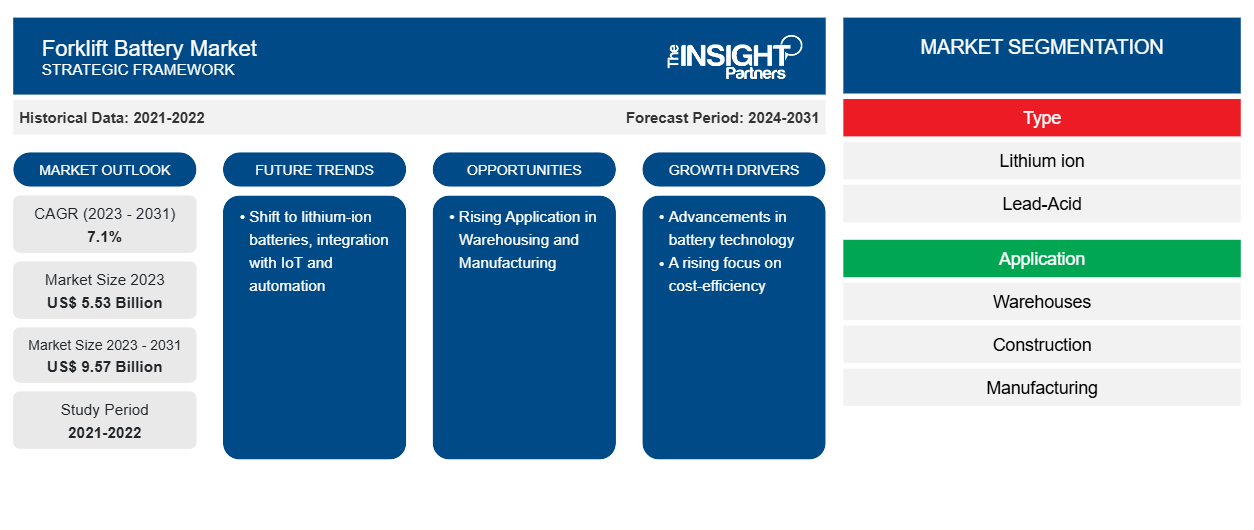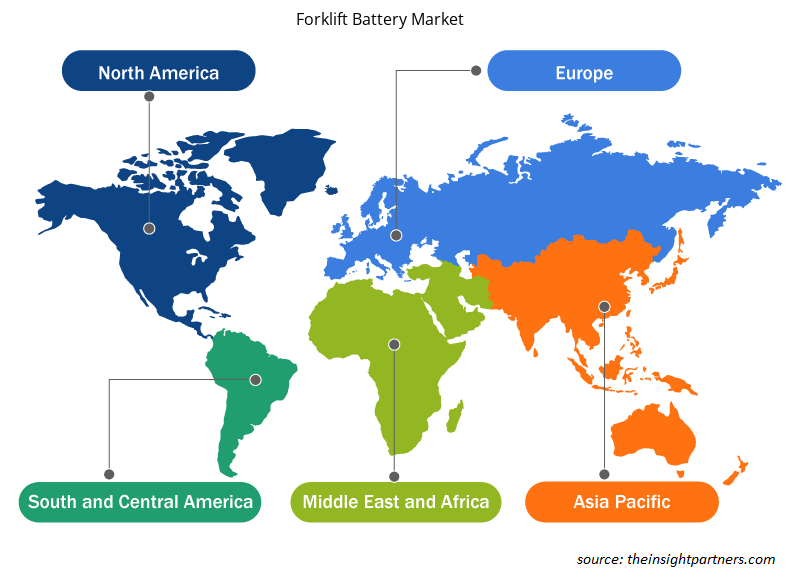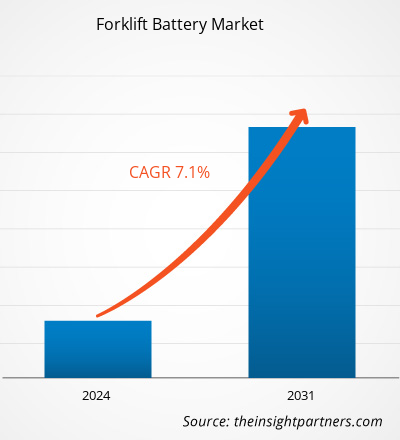Der Markt für Gabelstaplerbatterien hatte im Jahr 2024 ein Volumen von 5,94 Milliarden US-Dollar und dürfte bis 2031 ein Volumen von 9,23 Milliarden US-Dollar erreichen. Von 2025 bis 2031 wird mit einer durchschnittlichen jährlichen Wachstumsrate (CAGR) von 6,6 % gerechnet. Die Integration von Batterie-as-a-Service (BaaS) in Gabelstapler dürfte in den kommenden Jahren neue Trends auf den Markt bringen.
Marktanalyse für Gabelstaplerbatterien
Der Markt für Gabelstaplerbatterien verzeichnet ein starkes Wachstum. Dies ist auf das rasante Wachstum der Lager- und E-Commerce-Branche, die zunehmende Industrialisierung und den weltweiten Trend hin zu Elektrostaplern aus Nachhaltigkeits- und Kostengründen zurückzuführen. Diese Trends befeuern die Nachfrage nach fortschrittlichen Batterielösungen für längere Betriebszeiten und geringere Emissionen. Marktchancen bieten sich durch die Entwicklung von Schnell- und Zwischenladetechnologien, die Ausfallzeiten reduzieren und die Produktivität steigern. Darüber hinaus verbessern Innovationen bei intelligenten Batteriemanagementsystemen Leistung, Sicherheit und Energieeffizienz. Diese Fortschritte bieten vielversprechende Perspektiven für Hersteller und Stakeholder, die den steigenden Anforderungen der Materialflussbranche gerecht werden möchten.
Marktübersicht für Gabelstaplerbatterien
Eine Gabelstaplerbatterie kann als Stromquelle für den Betrieb von Gabelstaplern und anderen Flurförderzeugen dienen und die für den Materialumschlag benötigte Energie liefern. Gabelstapler verwenden typischerweise Blei-Säure- oder Lithium-Ionen-Batterien (Li-Ionen). Letztere erfreuen sich unter anderem aufgrund ihrer schnelleren Ladefähigkeit, längeren Lebensdauer und geringeren Umweltbelastung größerer Beliebtheit. Die Nachfrage nach Gabelstaplerbatterien ist mit der zunehmenden Beliebtheit von Elektrostaplern deutlich gestiegen. Elektrostapler werden aufgrund ihrer Nachhaltigkeit, ihres geringeren Wartungsbedarfs und ihrer Kosteneffizienz im Vergleich zu herkömmlichen Gabelstaplern mit Verbrennungsmotor (ICE) bevorzugt. Die europäische und nordamerikanische Industrie legt bekanntermaßen Wert auf umweltfreundlichere Lösungen zur Reduzierung ihres CO2-Fußabdrucks, was die Nachfrage nach Elektrostaplern weiter ankurbelt. Gabelstaplerbatterien spielen eine zentrale Rolle in der Logistik, Lagerhaltung und Fertigung, wo sie verschiedene Maschinen antreiben, die für den Materialumschlag und den Transport unerlässlich sind. Neben der zunehmenden Verbreitung von Elektrostaplern fördert auch die zunehmende Automatisierung in Lagern verschiedener Industriezweige das Marktwachstum.
Sie erhalten kostenlos Anpassungen an jedem Bericht, einschließlich Teilen dieses Berichts oder einer Analyse auf Länderebene, eines Excel-Datenpakets sowie tolle Angebote und Rabatte für Start-ups und Universitäten
Markt für Gabelstaplerbatterien: Strategische Einblicke

-
Informieren Sie sich über die wichtigsten Markttrends in diesem Bericht.Dieses KOSTENLOSE Beispiel umfasst Datenanalysen, von Markttrends bis hin zu Schätzungen und Prognosen.
Markttreiber und Chancen für Gabelstaplerbatterien
Ausbau von Lagerhaltung und E-Commerce
Die E-Commerce-Branche floriert aufgrund der zunehmenden Verbreitung von Internet und Smartphones, der sich wandelnden Verbraucherpräferenzen und des technologischen Fortschritts. Darüber hinaus nimmt der grenzüberschreitende E-Commerce zu, da Verbraucher international nach einzigartigen Produkten zu wettbewerbsfähigen Preisen suchen. Laut Eurostat ist in der EU der Anteil der Unternehmen, die eine E-Sales-Strategie verfolgten, von 17,21 % im Jahr 2013 auf 23,83 % im Jahr 2023 gestiegen. Viele E-Commerce -Unternehmen eröffnen Lager auf der ganzen Welt. So hat beispielsweise Amazon, ein E-Commerce-Riese, im August 2023 sein erstes Fulfillment-Center in den Niederlanden eröffnet. Mit der neuen Anlage kann der Online-Marktplatz niederländische Anfragen ohne Verzögerung erfüllen. Das schnelle Wachstum des E-Commerce hat zu einer erhöhten Nachfrage nach effizienten und sauberen Materialflusslösungen in Lagern geführt. Unternehmen wie Amazon und DHL reagieren darauf, indem sie Flotten von batteriebetriebenen Gabelstaplern einsetzen, um die Betriebseffizienz zu steigern und die Umweltbelastung zu reduzieren. So stellte DHL Supply Chain im März 2022 seine neueste Reihe autonomer Gabelstapler auf dem europäischen Festland vor; diese Palettentransporter waren die jüngste Ergänzung seines Mehrbenutzerlagers im belgischen Bornem. Die Installation autonomer Indoor-Roboter für den Palettentransport in Innenräumen war Teil der Strategie „Beschleunigte Digitalisierung“ des Unternehmens. Der zunehmende Online-Handel verändert die Logistiklandschaft und veranlasst Unternehmen, in automatisierte Lager und batteriebetriebene Gabelstapler zu investieren. Dieser Wandel wirkt sich direkt auf die Nachfrage nach effizienten und langlebigen Gabelstaplerbatterien, insbesondere Lithium-Ionen- und Blei-Säure-Batterien, aus, um den Rund-um-die-Uhr-Betrieb zu gewährleisten.
Entwicklungen bei Schnell- und Gelegenheitsladefunktionen
Mit der weltweiten Verbreitung von Elektrostaplern rücken fortschrittliche Ladelösungen wie Schnellladen und Gelegenheitsladen immer mehr in den Fokus. Diese Methoden erweisen sich für Unternehmen mit Mehrschichtbetrieb als wertvoll, da sie Ausfallzeiten reduzieren und die Effizienz steigern können. Traditionell durchlaufen Gabelstaplerbatterien einen konventionellen Ladezyklus, der 8 Stunden Betrieb, 8 Stunden Laden und weitere 8 Stunden Kühlen umfasst. Dieser Zyklus schränkt die Batterieverfügbarkeit ein und erfordert oft den Kauf zusätzlicher Batterien, um den Betrieb über mehrere Schichten hinweg aufrechtzuerhalten. Dies erhöht sowohl die Kosten als auch den Lagerbedarf. Schnell- und Gelegenheitslademethoden begegnen dieser Herausforderung, indem sie es Gabelstaplerfahrern ermöglichen, während kurzer Pausen, Essenszeiten oder über Nacht ihre Batterien anzuschließen. Dadurch wird die Batterieladung im Bereich von 40–80 % gehalten, sodass die Gabelstapler den ganzen Tag über einsatzbereit sind. Um die Batteriegesundheit zu erhalten und Spitzenleistung zu gewährleisten, ist es weiterhin wichtig, wöchentlich eine Ausgleichsladung durchzuführen, die die Batterie auf 100 % lädt und Sulfatbildung vorbeugt.
Da immer mehr Unternehmen die Betriebszeit verbessern und die Betriebskosten senken möchten, wird die Nachfrage nach Batterien und Ladesystemen, die mit diesen Methoden kompatibel sind, voraussichtlich steigen. Die Umstellung auf Schnell- und Zwischenladen bietet daher erhebliche Wachstumschancen für den Markt für Gabelstaplerbatterien.
Segmentierungsanalyse des Marktberichts für Gabelstaplerbatterien
Wichtige Segmente, die zur Ableitung der Marktanalyse für Gabelstaplerbatterien beigetragen haben, sind Typ, Kapazität und Anwendung.
- Der Markt für Gabelstaplerbatterien ist je nach Typ in Lithium-Ionen-, Blei-Säure- und andere Batterien unterteilt. Das Blei-Säure-Segment dominierte den Markt im Jahr 2024.
- Basierend auf der Kapazität ist der Markt für Gabelstaplerbatterien in 0–600 Ah, 600–1.200 Ah und über 1.200 Ah segmentiert. Das Segment 0–600 Ah hatte im Jahr 2024 den größten Marktanteil.
- Der Markt für Gabelstaplerbatterien ist je nach Anwendung in die Bereiche Lager und Logistik, Bauwesen, Fertigung, Einzelhandel und Großhandel, Automobilindustrie und andere unterteilt. Das Fertigungssegment dominierte den Markt im Jahr 2024.
Marktanteilsanalyse für Gabelstaplerbatterien nach geografischer Lage
- Der Markt für Gabelstaplerbatterien ist in fünf Hauptregionen unterteilt: Nordamerika, Europa, Asien-Pazifik (APAC), Naher Osten und Afrika (MEA) sowie Süd- und Mittelamerika. Der Asien-Pazifik-Raum dominierte den Markt im Jahr 2024, gefolgt von Europa und Nordamerika.
- Das Wachstum des nordamerikanischen Marktes für Gabelstaplerbatterien ist auf die Expansion der Logistik- und Transportbranche sowie des E-Commerce zurückzuführen. Der Online-Einkauf hat in den USA in den letzten Jahren zugenommen. Das Census Bureau des Handelsministeriums gab bekannt, dass die geschätzten E-Commerce-Umsätze im US-Einzelhandel für das vierte Quartal 2024, bereinigt um saisonale Schwankungen, jedoch nicht um Preisschwankungen, 308,9 Milliarden US-Dollar betrugen, was einem Anstieg von 2,7 Prozent (±0,9) gegenüber dem dritten Quartal 2024 entspricht. Viele Logistikriesen auf dem Markt wie UPS, FedEx, USPS, XPO Logistics und Amazon erkannten die steigende Nachfrage nach Gabelstaplern in ihren Lagern. Diese Unternehmen haben erheblich in den Aufbau von Lagern und die Automatisierung ihrer Logistikabläufe investiert. So eröffnete United Parcel Service im November 2023 das größte Lager in Louisville, Kentucky, mit einer Fläche von ca. 20 Acres. Dieses Lager dient der Lagerung und Paketabwicklung. Die Investition von 79 Millionen US-Dollar umfasst die Installation von über 3.000 automatisierten Robotern und Industriefahrzeugen. Diese Roboter und Industriefahrzeuge übernehmen verschiedene Lageraufgaben, wie beispielsweise das Heben und Transportieren von Waren, und reduzieren so den Bedarf an manueller Arbeit.
- Der Markt für Gabelstaplerbatterien in Europa wird durch den wachsenden Lebensmittel- und Getränkesektor, die steigende Nachfrage nach Logistik und Transport sowie die wachsende Einkaufsbranche angetrieben. Die Logistikbranche benötigt Industriefahrzeuge wie Gabelstapler, um Güter von einem Ort zum anderen zu heben und zu transportieren. Laut den im Juli 2024 veröffentlichten Statistiken der Europäischen Kommission wurden 7,97 Milliarden US-Dollar in 134 Verkehrsinfrastrukturprojekte für eine nachhaltige, sichere und intelligente Verkehrsinfrastruktur investiert. Die strategischen Investitionen der EU dienten der Automatisierung der Transport- und Logistikinfrastruktur. Das Wachstum der Logistikbranche hat eine Nachfrage nach Elektrostaplern für den Materialtransport in Lagern geschaffen, was wiederum das Wachstum des Marktes für Gabelstaplerbatterien vorantreibt.
Regionale Einblicke in den Markt für Gabelstaplerbatterien
Die Analysten von Insight Partners haben die regionalen Trends und Faktoren, die den Markt für Gabelstaplerbatterien im Prognosezeitraum beeinflussen, ausführlich erläutert. Dieser Abschnitt behandelt auch die Marktsegmente und die geografische Lage von Gabelstaplerbatterien in Nordamerika, Europa, Asien-Pazifik, dem Nahen Osten und Afrika sowie Süd- und Mittelamerika.

- Erhalten Sie regionale Daten zum Markt für Gabelstaplerbatterien
Umfang des Marktberichts für Gabelstaplerbatterien
| Berichtsattribut | Details |
|---|---|
| Marktgröße im Jahr 2024 | 5,94 Milliarden US-Dollar |
| Marktgröße bis 2031 | 9,23 Milliarden US-Dollar |
| Globale CAGR (2025 – 2031) | 6,6 % |
| Historische Daten | 2021-2023 |
| Prognosezeitraum | 2025–2031 |
| Abgedeckte Segmente |
Nach Typ
|
| Abgedeckte Regionen und Länder |
Nordamerika
|
| Marktführer und wichtige Unternehmensprofile |
|
Marktteilnehmerdichte für Gabelstaplerbatterien: Auswirkungen auf die Geschäftsdynamik
Der Markt für Gabelstaplerbatterien wächst rasant. Die steigende Nachfrage der Endverbraucher ist auf Faktoren wie veränderte Verbraucherpräferenzen, technologische Fortschritte und ein stärkeres Bewusstsein für die Produktvorteile zurückzuführen. Mit der steigenden Nachfrage erweitern Unternehmen ihr Angebot, entwickeln Innovationen, um den Bedürfnissen der Verbraucher gerecht zu werden, und nutzen neue Trends, was das Marktwachstum weiter ankurbelt.
Die Marktteilnehmerdichte beschreibt die Verteilung der in einem bestimmten Markt oder einer bestimmten Branche tätigen Unternehmen. Sie gibt an, wie viele Wettbewerber (Marktteilnehmer) in einem bestimmten Marktraum im Verhältnis zu dessen Größe oder Gesamtmarktwert präsent sind.
Die wichtigsten Unternehmen auf dem Markt für Gabelstaplerbatterien sind:
- Akkumulatorenwerke HOPPECKE Carl Zoellner & Sohn GmbH
- Crown Equipment Corp
- Exide Industries Ltd
- EnerSys
- East Penn Fertigungsunternehmen
- Contemporary Amperex Technology Co Ltd
Haftungsausschluss : Die oben aufgeführten Unternehmen sind nicht in einer bestimmten Reihenfolge aufgeführt.

- Überblick über die wichtigsten Akteure auf dem Markt für Gabelstaplerbatterien
Neuigkeiten und aktuelle Entwicklungen zum Markt für Gabelstaplerbatterien
Der Markt für Gabelstaplerbatterien wird durch die Erhebung qualitativer und quantitativer Daten aus Primär- und Sekundärforschung bewertet. Dazu zählen wichtige Unternehmenspublikationen, Verbandsdaten und Datenbanken. Nachfolgend sind einige Entwicklungen im Markt für Gabelstaplerbatterien aufgeführt:
- BSL New Energy Technology Co., Ltd., ein führender chinesischer Hersteller von Lithiumbatterien, der hochwertige LiFePO4-Batterien für Antriebs- und Energiespeicheranwendungen anbietet, hat eine strategische Kooperationsvereinbarung mit REPT BATTERO Energy Co., Ltd. unterzeichnet, um Lithiumbatterielösungen für Gabelstapler anzubieten.
(Quelle: BSL New Energy Technology Co., Ltd., Pressemitteilung, Juli 2024)
- East Penn Manufacturing Co. stellt auf der ProMat 2025 in Chicago, Illinois, die NEUE Produktfamilie Deka Ready Power vor. Die Batteriefamilie Deka Ready Power unterstützt den stetig wachsenden Bedarf an wartungsfreien Produkten für Antriebsanwendungen. Sie bietet sowohl Lithium- als auch Gel-Technologien und bietet damit ein erstklassiges Preis-Leistungs-Verhältnis und niedrigste Gesamtbetriebskosten.
(Quelle: East Penn Manufacturing Co., Pressemitteilung, März 2025)
Marktbericht zu Gabelstaplerbatterien – Umfang und Ergebnisse
Der Bericht „Marktgröße und Prognose für Gabelstaplerbatterien (2021–2031)“ bietet eine detaillierte Analyse des Marktes, die die unten genannten Bereiche abdeckt:
- Marktgröße und Prognose für Gabelstaplerbatterien auf globaler, regionaler und Länderebene für alle wichtigen Marktsegmente, die im Rahmen des Geltungsbereichs abgedeckt sind
- Markttrends für Gabelstaplerbatterien sowie Marktdynamiken wie Treiber, Einschränkungen und wichtige Chancen
- Detaillierte PEST- und SWOT-Analyse
- Marktanalyse für Gabelstaplerbatterien mit wichtigen Markttrends, globalen und regionalen Rahmenbedingungen, wichtigen Akteuren, Vorschriften und aktuellen Marktentwicklungen
- Branchenlandschafts- und Wettbewerbsanalyse mit Marktkonzentration, Heatmap-Analyse, prominenten Akteuren und jüngsten Entwicklungen auf dem Markt für Gabelstaplerbatterien
- Detaillierte Firmenprofile
- Historische Analyse (2 Jahre), Basisjahr, Prognose (7 Jahre) mit CAGR
- PEST- und SWOT-Analyse
- Marktgröße Wert/Volumen – Global, Regional, Land
- Branchen- und Wettbewerbslandschaft
- Excel-Datensatz
Aktuelle Berichte
Verwandte Berichte
Erfahrungsberichte
Grund zum Kauf
- Fundierte Entscheidungsfindung
- Marktdynamik verstehen
- Wettbewerbsanalyse
- Kundeneinblicke
- Marktprognosen
- Risikominimierung
- Strategische Planung
- Investitionsbegründung
- Identifizierung neuer Märkte
- Verbesserung von Marketingstrategien
- Steigerung der Betriebseffizienz
- Anpassung an regulatorische Trends






















 Kostenlose Probe anfordern für - Markt für Gabelstaplerbatterien
Kostenlose Probe anfordern für - Markt für Gabelstaplerbatterien